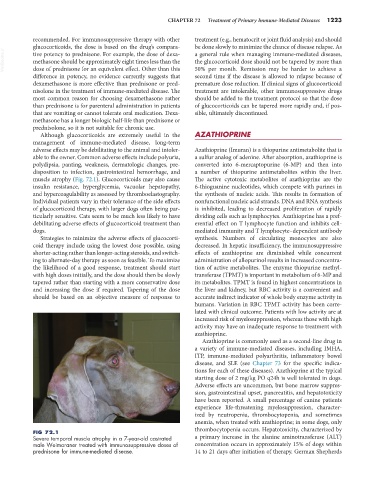Page 1251 - Small Animal Internal Medicine, 6th Edition
P. 1251
CHAPTER 72 Treatment of Primary Immune-Mediated Diseases 1223
recommended. For immunosuppressive therapy with other treatment (e.g., hematocrit or joint fluid analysis) and should
glucocorticoids, the dose is based on the drug’s compara- be done slowly to minimize the chance of disease relapse. As
VetBooks.ir tive potency to prednisone. For example, the dose of dexa- a general rule when managing immune-mediated diseases,
the glucocorticoid dose should not be tapered by more than
methasone should be approximately eight times less than the
dose of prednisone for an equivalent effect. Other than this
second time if the disease is allowed to relapse because of
difference in potency, no evidence currently suggests that 50% per month. Remission may be harder to achieve a
dexamethasone is more effective than prednisone or pred- premature dose reduction. If clinical signs of glucocorticoid
nisolone in the treatment of immune-mediated disease. The treatment are intolerable, other immunosuppressive drugs
most common reason for choosing dexamethasone rather should be added to the treatment protocol so that the dose
than prednisone is for parenteral administration in patients of glucocorticoids can be tapered more rapidly and, if pos-
that are vomiting or cannot tolerate oral medication. Dexa- sible, ultimately discontinued.
methasone has a longer biologic half-life than prednisone or
prednisolone, so it is not suitable for chronic use.
Although glucocorticoids are extremely useful in the AZATHIOPRINE
management of immune-mediated disease, long-term
adverse effects may be debilitating to the animal and intoler- Azathioprine (Imuran) is a thiopurine antimetabolite that is
able to the owner. Common adverse effects include polyuria, a sulfur analog of adenine. After absorption, azathioprine is
polydipsia, panting, weakness, dermatologic changes, pre- converted into 6-mercaptopurine (6-MP) and then into
disposition to infection, gastrointestinal hemorrhage, and a number of thiopurine antimetabolites within the liver.
muscle atrophy (Fig. 72.1). Glucocorticoids may also cause The active cytotoxic metabolites of azathioprine are the
insulin resistance, hyperglycemia, vacuolar hepatopathy, 6-thioguanine nucleotides, which compete with purines in
and hypercoagulability as assessed by thromboelastography. the synthesis of nucleic acids. This results in formation of
Individual patients vary in their tolerance of the side effects nonfunctional nucleic acid strands. DNA and RNA synthesis
of glucocorticoid therapy, with larger dogs often being par- is inhibited, leading to decreased proliferation of rapidly
ticularly sensitive. Cats seem to be much less likely to have dividing cells such as lymphocytes. Azathioprine has a pref-
debilitating adverse effects of glucocorticoid treatment than erential effect on T lymphocyte function and inhibits cell-
dogs. mediated immunity and T lymphocyte–dependent antibody
Strategies to minimize the adverse effects of glucocorti- synthesis. Numbers of circulating monocytes are also
coid therapy include using the lowest dose possible, using decreased. In hepatic insufficiency, the immunosuppressive
shorter-acting rather than longer-acting steroids, and switch- effects of azathioprine are diminished while concurrent
ing to alternate-day therapy as soon as feasible. To maximize administration of allopurinol results in increased concentra-
the likelihood of a good response, treatment should start tion of active metabolites. The enzyme thiopurine methyl-
with high doses initially, and the dose should then be slowly transferase (TPMT) is important in metabolism of 6-MP and
tapered rather than starting with a more conservative dose its metabolites. TPMT is found in highest concentrations in
and increasing the dose if required. Tapering of the dose the liver and kidney, but RBC activity is a convenient and
should be based on an objective measure of response to accurate indirect indicator of whole body enzyme activity in
humans. Variation in RBC TPMT activity has been corre-
lated with clinical outcome. Patients with low activity are at
increased risk of myelosuppression, whereas those with high
activity may have an inadequate response to treatment with
azathioprine.
Azathioprine is commonly used as a second-line drug in
a variety of immune-mediated diseases, including IMHA,
ITP, immune-mediated polyarthritis, inflammatory bowel
disease, and SLE (see Chapter 73 for the specific indica-
tions for each of these diseases). Azathioprine at the typical
starting dose of 2 mg/kg PO q24h is well tolerated in dogs.
Adverse effects are uncommon, but bone marrow suppres-
sion, gastrointestinal upset, pancreatitis, and hepatotoxicity
have been reported. A small percentage of canine patients
experience life-threatening myelosuppression, character-
ized by neutropenia, thrombocytopenia, and sometimes
anemia, when treated with azathioprine; in some dogs, only
thrombocytopenia occurs. Hepatotoxicity, characterized by
FIG 72.1
Severe temporal muscle atrophy in a 7-year-old castrated a primary increase in the alanine aminotransferase (ALT)
male Weimaraner treated with immunosuppressive doses of concentration occurs in approximately 15% of dogs within
prednisone for immune-mediated disease. 14 to 21 days after initiation of therapy. German Shepherds

